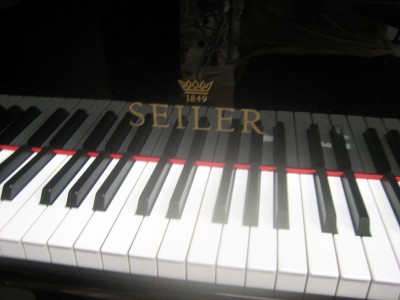Seiler 鋼琴是擁有超過 170 年歷史的德國名琴品牌,以其精緻工藝與優雅音色聞名於世。無論是專業演奏家還是學習者,Seiler 都能提供不同層次的選擇。
發展與傳承
-
1849 年由 Eduard Seiler 在德國 Liegnitz 創立。
-
20 世紀初成為德國最大的鋼琴製造商之一,以創新與高品質著稱。
-
2008 年加入韓國 Samick 三益樂器集團,在保持德國工藝的同時,拓展了全球市場。
製造體系
Seiler 現今有兩大產品線:
-
Seiler(德國製造)
-
產地:德國 Kitzingen。
-
完全手工製作,使用德國材料與傳統工藝。
-
擁有 「Made in Germany」 認證,屬於專業級與音樂學院級別。
-
-
Johannes Seiler(亞洲製造)
-
由 Seiler 設計並在亞洲(主要於三益工廠)生產。
-
定位於學生與家庭使用,價格更親民。
-
保留 Seiler 設計理念,但製造成本較低。
-
品質與音色
-
德國 Seiler 系列
-
音色清澈、明亮,低音渾厚有力。
-
採用專利 Membrator System,提升共鳴與音色穩定性。
-
適合專業演奏與高階需求。
-
-
Johannes Seiler 系列
-
音色溫暖柔和,適合學習與日常彈奏。
-
性價比高,為入門與中階學習者提供良好選擇。
-
Seiler 在香港同時提供 德國製造的高端系列與亞洲製造的親民系列,滿足不同層次的需求。品牌以其悠久歷史、創新技術與穩定品質,成為香港鋼琴市場上備受推崇的選擇。
在鋼琴的結構中,音板(soundboard) 被譽為鋼琴的「心臟」,因為它決定了音色的共鳴與延展。德國 Seiler 鋼琴以創新著稱,其中最具代表性的專利之一就是 Membrator System。這項設計突破了傳統共鳴板的製作方式,使 Seiler 鋼琴擁有獨特而持久的音色表現。
什麼是 Membrator System
-
Membrator System 是 Seiler 開發的 專利共鳴板結構。
-
傳統音板通常在中央最厚(約 10 毫米),邊緣逐漸變薄(約 6 毫米)。
-
Seiler 的 Membrator 設計則相反:中央仍保持約 10 毫米,但在靠近鋼琴內框的 內緣處 被削薄至約 6 毫米。
-
這樣的設計讓 音板 像「薄膜」一樣更自由振動,提升整體音色的靈敏度與均衡度。
系統帶來的優勢
-
更強的共鳴:音板 能更有效率地回應琴弦震動。
-
音色投射力提升:聲音更飽滿,穿透力更佳。
-
長期穩定性:保持彈性,延緩音色老化。
-
Seiler 獨特音色:高音清澈明亮,低音渾厚有力,整體音色均衡而富有表現力。
Seiler Membrator System 是該品牌的核心技術之一,透過創新的音板設計,讓鋼琴在音色表現與耐用度上都更勝一籌。這也是為什麼 Seiler 鋼琴能在眾多歐洲品牌中脫穎而出,成為專業演奏家與音樂學院的青睞之選。
Seiler 鋼琴製造廠有限公司(Seiler Pianofortefabrik GmbH)是一家創立於 1849 年的德國歷史悠久鋼琴製造商,曾在過去面臨財務困難。大約在 2009 年,Seiler 與其他幾家德國知名鋼琴品牌一樣,受到全球經濟衰退的影響,導致國際訂單大幅下滑——儘管德國本地銷售保持穩定,海外需求卻驟降了三分之二,使得部分公司(包括 Seiler)陷入破產。
不過,Seiler 隨後得以重整,並於 2008 年被南韓樂器公司 Samick 收購。
收購後的發展概況
-
雙重生產基地:
Seiler 鋼琴目前在兩個地點生產:
-
德國(Kitzingen):高階 Seiler 型號仍在德國手工製造,延續品牌的傳統與工藝。
-
印尼(西爪哇):Samick 在此地生產較平價的 Seiler 品牌鋼琴,常見子品牌包括「Eduard Seiler」與「Johannes Seiler」。
-
-
品牌分級策略:
Samick 將 Seiler 品牌分為三個層級:
-
Seiler:德國製造的頂級系列。
-
Eduard Seiler:中階型號,印尼製造。
-
Johannes Seiler:入門級型號,同樣由印尼生產。
-
-
設計理念:
儘管所有權已轉移,Seiler 強調其德國製鋼琴仍由原廠獨立設計與製造,確保其獨特音色與品質不受影響。
-
全球拓展:
借助 Samick 的全球銷售網絡,Seiler 鋼琴在亞洲與北美市場的能見度大幅提升。
Pianos made by: Ed. Seiler Pianofortefabrik, Kitzingen, Germany,
with Samick Musical Instrument Mfg. Co. Ltd., Bogor, West Java, Indonesia
Eduard Seiler established his piano company in 1849 at Wilhelmstrasse 17-19 in Liegnitz, Germany. His goal as a piano maker was to build pianos for both professional use as well as for the average, middle class home. He did this with great care using high quality materials, handcrafted in his small workshop.
Despite the setback of wars from about 1864 to 1871, Seiler flourished receiving several awards for excellence and expanding his operations to a larger factory by 1873. When Eduard died in 1875, his sons, Max and Paul, took over the firm. Max and Paul died young, but the youngest son, Johannes Seiler had been learning the business at his father’s factory and other factories throughout Europe, and the piano building craft by completing an apprenticeship. Johannes then took over the company in 1879, and the Seiler company soon became one of Germany’s leading manufacturers, winning a series of awards at worldwide exhibitions. Expansion continued over the next several decades with new factories and international success.
In 1923 Anton Seiler-Dutz, Johannes Seiler’s son-in-law, took control of thecompany, continuing success with Seiler becoming the largest piano manufacturer in Eastern Germany. The factory at Liegnitz was nationalized by the communist government after World War II, but the invaluable moulds, drawings and designs of their rich history of piano building were saved by Anton’s son, Steffan. Steffan left Liegnitz (now part of Poland), moving the company to Copenhagen, Denmark in 1945, where he started to build pianos again until 1960. In 1963 production was moved to Kitzingen, Germany, where it remains to this day. In 1999 Steffan died and the firm was then run by his wife, Ursula Seiler.
In 2008 Seiler was sold to Korean firm, Samick Music Corp., who agreed to manufacture pianos of the highest quality, to continue the tradition of the Seiler name.
Official Website: http://www.seiler-pianos.de/en/homepage.html
湯 先生/ Mr. Tong
英國註冊鋼琴技師 / Registered Piano Technician (MPTA)

Leave a Reply